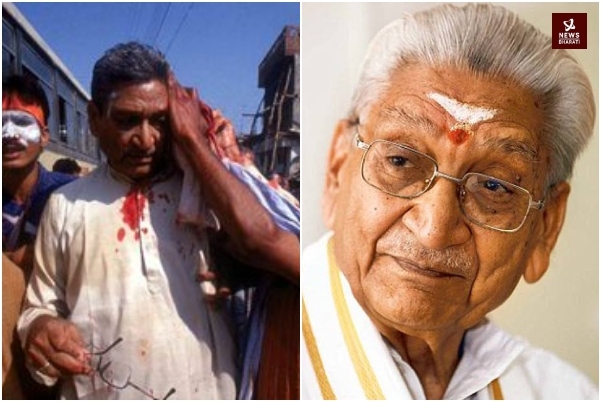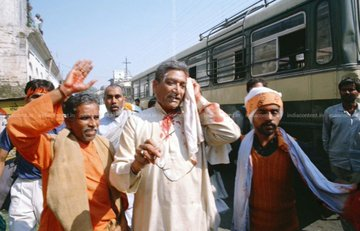Ashok Singhal, the Man who Dedicated his Life to Ram Janmabhoomi
06 Dec 2023 10:54:09
(The article is based on a X thread)
On 6th December, India witnessed the 31st anniversary of the Babri Masjid demolition. On this day, thousands of Karsevaks had brought down the disputed structure at Ram Janmabhoomi in Ayodhya.
On 6th December, India witnessed the 31st anniversary of the Babri Masjid demolition. On this day, thousands of Karsevaks had brought down the disputed structure at Ram Janmabhoomi in Ayodhya.
The movement marked the first significant step towards reclaiming the birthplace of Bhagwan Shri Ram which was forcibly occupied by Mughal rulers, as a symbol of Islam’s victory over the Hindu faith. The movement culminated with the Supreme Court granting the disputed site to the Hindus marking a landmark judgment in the protracted case in November 2019.

Several prominent karsevaks contributed to this movement but every Indian needs to know about Ashok Singhal, the man who dedicated his life to Ram Janmabhoomi Andholan until his last breath.
Born on September 27, 1926, in Agra, Ashok Singhal, a metallurgical engineering graduate from BHU, joined the RSS after his graduation. He was actively involved with RSS under the guidance of Balasaheb Deoras. He became a full-time pracharak working primarily around Gorakhpur. Later, in Varanasi, he came into contact with Rajendra Singh, a physics professor from Allahabad University, better known as Raju Bhaiyya. Both were arrested during the Emergency.
VHP transformation
It was under Ashok Singhal, that VHP underwent a complete transformation, till then it was headed by likes of K.M.Munshi, the Mysore Maharaja Jaya Chamaraj Wodeyar, C.P.Ramaswami Aiyer, was seen more as an elite organization, concentrating mostly on social, cultural activities.
Ashok Singhal took VHP to the masses, as he fought for causes like a ban on cow Slaughter and conversions vigorously on the ground, leading protests. The turning moment came after the Meenakshipuram incident took place.
In 1981, around 1200 Dalits in a village in Tamil Nadu called Meenakshipuram, converted to Islam due to discrimination. This incident shook the Hindu society posing a grave challenge. Singhal began to fight the conversion vigorously on the ground. He joined hands with Hindu Munnani and tried to do a Ghar Wapsi, but it did not succeed, with only 7 people willing.
He found out that most of the Dalits had converted due to a lack of access to temples in the area and got around 200 temples built in the area, where everyone would have access irrespective of caste, to counter the conversions.
During the entire episode, he coordinated with a whole lot of Sadhus, and Sants an association that would stand him in good stead later on. He organized the first Dharma Sansad in 1984 at Delhi’s Vigyan Bhavan, which saw Sadhus and Sants from all over the country participating.
Ram Janmabhoomi Andholan
It was at this Sansad, that the Ram Janmabhoomi movement was born, with a vow to build the Ram Mandir at Ayodhya. However, Indira Gandhi's assassination, the anti-Sikh riots, and Rajiv coming back to power on a sympathy wave, meant VHP then had to keep a low profile.
The newly formed BJP lost badly in the sympathy wave as Rajiv rode to win the 1984 elections and BJP won just 2 seats, which saw many of its stalwart leaders including Vajpayee losing. Post the election result, L. K. Advani assumed charge of BJP as President and Hindutva as its ideology. BJP under Advani backed Ram Janmabhoomi Andholan aggressively, making it a part of their manifesto now.
In 1990, Advani took out the Rath Yatra, in support of the Ram Janmabhoomi, however, he was arrested in Bihar on the orders of then CM Laloo Prasad Yadav.
During this time, Singhal led the Karseva at Ayodhya, in front, despite the restrictions imposed by Mulayam Singh Yadav. The police cracked down on the protestors and thousands were killed, the bodies thrown in Saryu river.


Ashok Singhal's head bleeding from a lathi blow, while leading the Kar Sevaks at Ayodhya.
The 1991 General elections saw P.V. Narasimha Rao assume charge as PM, and BJP winning a huge majority in UP with Kalyan Singh being sworn in as CM, who openly called for the construction of a Ram Mandir in Ayodhya. He however ensured that the VHP would still have charge of the Ram Mandir movement, coordinating with the likes of Acharya Giriraj Kishore, Ramchandra Das Paramahans, and Mahant Avaidyanath.
And at the Dharm Sansad in Delhi in October 1992, he openly announced that Kar Seva would be held in Ayodhya. On 6th December as the kar sevaks began to gather at Ayodhya, Kalyan Singh assured SC that no disturbance would take place, and law and order will be maintained.
All the main leaders of the BJP like Advani, Uma Bharati, and Murali Manohar Joshi were present at Ayodhya, except Vajpayee. As the crowd of around 2 lakh people mounted the domes of Babri, the demolition began and it soon collapsed.
Ashok Singhal was so dedicated to the cause of Ram Janmabhoomi, that even when BJP was in power, he did not hesitate to criticize Vajpayee, for neglecting the very cause that bought them to power. He even sat on a hunger strike in protest against the BJP Govt, against what he felt was the "inaction" on the Ram Janmabhoomi issue, which ended only when he was force-fed, leading to an unfortunate fallout.
Ashok Singhal would later become one of PM Modi's staunchest supporters, one of the few who backed him in BJP, hoping he would do justice to the Ram Janmabhoomi Andholan, that he held so close to his heart.
In his later years however he had to step down due to ill health, and in 2015 passed away in Gurgaon at the age of 89. Till his death, Ashok Singhal held the cause of Ram Janmabhoomi closest to his heart never once compromising on him. He dedicated his entire life for the Hindu cause while living a simple, spartan life, never compromising on the ideals he believed in.